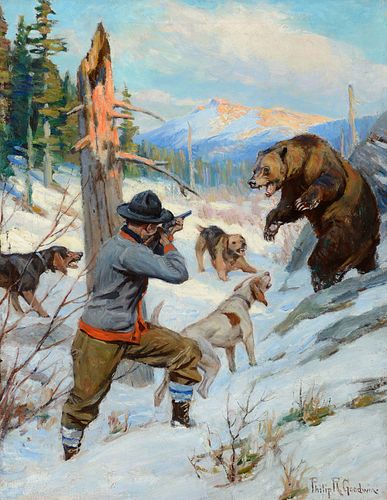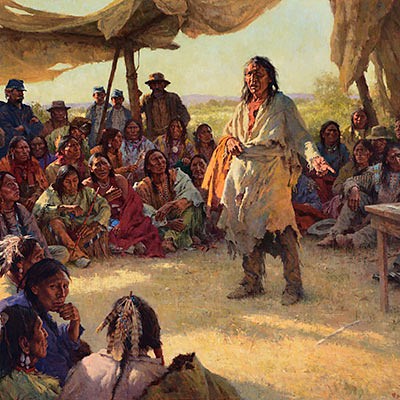Philip R. Goodwin (1881 – 1935) — A Strenuous Fight
About Seller
11944 North Tracey Road
Hayden, ID 83835
United States
Coeur d’Alene Art Auction specializes in the finest classical Western and American Art representing past masters and outstanding contemporary artists. The auction principals have over 100 years of combined experience in selling fine art and have netted their clients over $325 million in the last fif...Read more
Two ways to bid:
- Leave a max absentee bid and the platform will bid on your behalf up to your maximum bid during the live auction.
- Bid live during the auction and your bids will be submitted real-time to the auctioneer.
Bid Increments
| Price | Bid Increment |
|---|---|
| $0 | $100 |
| $2,000 | $250 |
| $5,000 | $500 |
| $10,000 | $1,000 |
| $20,000 | $2,500 |
| $50,000 | $5,000 |
| $100,000 | $10,000 |
| $200,000 | $25,000 |
| $500,000 | $50,000 |
| $1,000,000 | $100,000 |
About Auction
Jul 15, 2023
The 2023 Coeur d’Alene Art Auction, to be held July 15 in Reno, Nevada, will feature 324 selections of unparalleled quality in Western & American Art from historical and contemporary artists such as Maynard Dixon, Howard Terpning, W. Herbert Dunton, Joseph H. Sharp, Charles M. Russell, and more. Coeur d'Alene Art Auction info@cdaartauction.com
- Lot Description
Philip R. Goodwin (1881 – 1935)
A Strenuous Fight
oil on canvas
30 × 22 inches
signed lower right
VERSO
Label, C. M. Russell Museum, Great Falls, Montana
An original framed calendar from 1926 featuring A Strenuous Fight will accompany the lot.
According to Goodwin biographer Dr. Larry Len Peterson, “This masterwork stands at the pinnacle of Goodwin’s bear hunting paintings. It is a stellar example of why for over a hundred years Goodwin has been recognized as America’s sporting artist. For example, early on famed author Jack London appreciated his genius and called on Goodwin to illustrate what would become one of the greatest and most endearing publications in American history, The Call of the Wild (1903). Likewise, Theodore Roosevelt, the most celebrated hunter in the world, commissioned the young wunderkind to illustrate his classic African Game Trails (1909).
“Philip Russell Goodwin was born on September 16, 1881 – not 1882 as often erroneously written – in Norwich, Connecticut. Early on he was recognized as a child prodigy, attending the prestigious Rhode Island School of Design when he was only fourteen. He soon caught the eye of America’s most famous illustrator, Howard Pyle, who taught such greats as Maxfield Parrish, N. C. Wyeth, Harvey Dunn, Frank Schoonover, W. H. D. Koerner, and Frank Stick. Pyle founded the Brandywine School in Chadds Ford, Pennsylvania, where most of the great illustrators would train. In 1907 when he visited his friend Charles M. Russell in Montana, Goodwin had already illustrated a dozen books; dozens of magazine articles; three covers of the great magazine of the day, The Saturday Evening Post; and countless sporting advertisements – one of the most famous would be Winchester’s Horse and Rider (1919). Goodwin was only twenty-five years old.
“A popular subject during the ‘Golden Age of Illustration’ (1880-1930) was sporting art – hunting, the king. Why did hunting become so popular and inspire such great artists as Goodwin? Look no further than Theodore Roosevelt, the American West’s president. He was idolized by generations of citizens. What was manlier than hunting? In many ways, he carried the baton of Western identity handed off by Buffalo Bill Cody, as he championed the strenuous life. For almost thirty years, many of Goodwin’s finest and most memorable paintings appeared first on calendars and on the covers of periodicals such as Popular Magazine, Top Notch Magazine, Outdoor Recreation, Outdoor Life, and Rod and Gun. All were widely circulated around the country. Yet, the bulk of his finest work landed on the front covers of Outdoor Recreation. From 1922 to 1925 twenty-one were featured. Of those, seven were bear hunting predicament paintings. Some of his most famous bear paintings – a favorite subject – were: A Fighting Chance (similar to Russell’s A Disputed Trail), Who’s Coming (standing bears), A ‘Bear’ Chance (for Nabisco’s Cream of Wheat), and It’s a Bear (his last great bear painting, 1933).
“As an experienced hunter, Goodwin learned much about the daily habits of grizzly bears from his time spent with Charles M. Russell in Glacier National Park (1907, 1910) and Carl Rungius in the Canadian Rockies near Banff, Alberta (1911). The setting for this painting is a spring day in the Rockies, just after the bear has awakened from hibernation. Perhaps because the grizzly bear (Ursus horriblus) is the most feared and respected animal in the West, Goodwin often enjoyed placing these animals in a playful and whimsical manner with anthropomorphic poses. For centuries the grizzly had been the admirable winner of the survival of the fittest – that was until the white man arrived. Before that, they could be found across many regions of North America. From experience, on numerous occasions Goodwin observed that an upset bear will rise on its haunches, survey the situation, and retreat, dance around or if threatened, attack. There lies the predicament in A Strenuous Fight. Wary humans and prey learned quickly that the grizzly could run up to thirty miles-per-hour. Because of these traits, most big-game hunters in Goodwin’s lifetime considered the grizzly bear the ultimate trophy. In the 1860s a California journalist wrote, ‘If you kill a grizzly bear, it is triumph worthy of enjoying; if you get killed yourself, some of the newspapers will give a friendly notice.’
“A Strenuous Fight was first published in December 1924 on the front cover of Outdoor Recreation: The Magazine that brings the Outdoors In. Of note on the cover is a fourth dog on the left mid-margin that was subsequently removed from the painting for its latter calendar appearances. Goodwin loved dogs, but some art supervisor must have decided that three were enough. On a personal note, this masterwork was the first painting I photographed for my Goodwin book. It was owned by Neil Snyder, a close friend and expert on Goodwin’s advertising art. With impeccable provenance and subject matter, it would be difficult to top this fine offering.”
PROVENANCE
Paul Masa, Kalispell, Montana, 1992
Neil and Sharon Snyder, Great Falls, Montana
LITERATURE
Larry Len Peterson, Philip R. Goodwin: America’s Sporting & Wildlife Artist, Coeur d’Alene Art Auction and Settlers West Galleries, 2001, pp. 222, 245, illustrated
Hal Boggess, Classic Hunting Collectibles, KP Books, 2005, p. 172, illustrated
Larry Len Peterson, The American West Reimagined: Gems from the Coeur d’Alene Art Auction, Coeur d’Alene Art Auction, 2021, pp. 381-91
View More InformationCondition
Surface is in good condition. Bar marks along the top and the left, and hairline cracks in snow. No signs of restoration.
- Buyer's Premium



 EUR
EUR CAD
CAD AUD
AUD GBP
GBP MXN
MXN HKD
HKD CNY
CNY MYR
MYR SEK
SEK SGD
SGD CHF
CHF THB
THB














